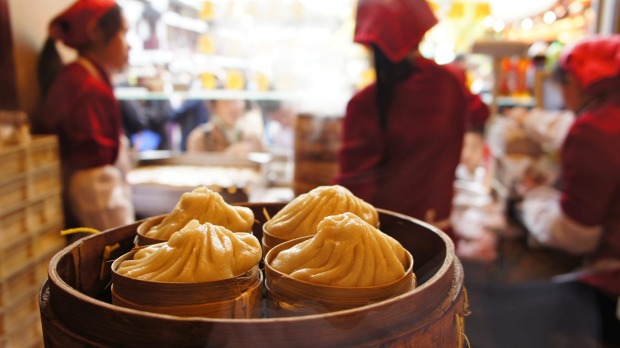
For all China's nouveau-riche dining excesses, you can't do better than street snacks or "little eats", as locals call them. It's the comfort food your grandmother would cook if she were Chinese: chilli-studded noodles, steamed dumplings, roast pork buns sticky with caramel sauce, baked sweet potatoes that warm your hands.
Temptation is everywhere. Eat at busy stalls and you'll be fine. In Beijing, it's hard to resist a fat oil-fried pancake stuffed with meat. In Shandong Province they're crepe-thin, with an egg cracked on top, then rolled for your eating ease. Everywhere, steamed dumplings are a popular late-night snack. Noodles are as various as Italian pasta. Buckwheat noodles are served with sesame sauce, liangfen noodles shaved off a block of bean-starch jelly and doused in chilli oil. In Yunnan Province, rice noodles are eaten in a piping-hot broth with sliced chicken and mushrooms.
Even breakfast is catered for. There's a street in Wuhan nicknamed Breakfast Street (Hubuxiang) where you can try tang gao, a deep-fried doughnut made with rice flour and sugar. In Shanghai, glutinous rice balls are popular, filled with pickles or egg. In Pingyao (Shanxi Provence) you can buy wrinkled apricots and sesame balls filled with red-bean paste, and street vendors cook ears of corn over charcoal braziers. And don't forget dessert. In country towns, vendors still spin animals from toffee. In Kaifeng (Henan Province), the local favourite is hot jelly, poured in liquid form over fruit, berries or nuts from huge kettles with dragon-head spouts.
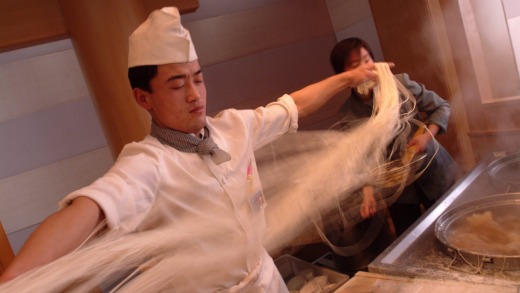
Sadly, with increased road and foot traffic, city governments are clamping down on street snacking. Many stalls are regulated to particular (often pedestrian) food streets, or have retreated indoors to hawker centres. Enjoy while you can.
It's impossible to go hungry in Shanghai: stalls across the city sell dumplings, amazingly good bowls of noodles, egg pancakes, grilled lamb skewers and pork buns sprinkled with sesame seeds. More sophisticated fare includes roast duck slices atop rice, or frogs' legs in ginger.
Nothing in Shanghai beats xiao longbao. This Shanghai obsession is a dumpling with an almost translucent skin encasing a hot, flavoursome broth that explodes into your mouth.
Brian Johnston
Look out for crab-shell pies, which can have all kinds of fillings (both savoury and sweet) and are named for their appearance. For an old-fashioned treat, eggs boiled in green tea and soy sauce are a peculiar colour, but go down well at breakfast, accompanied by fried bread sticks.
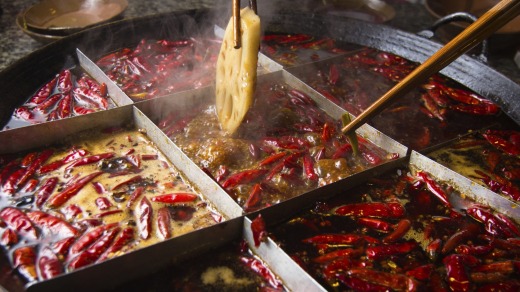
To my mind, nothing in Shanghai beats xiao longbao. This Shanghai obsession is a dumpling with an almost translucent skin encasing a hot, flavoursome broth that explodes into your mouth – or, if you aren't careful, over your clothes – as you bite into it. Only the adept can pick one up with chopsticks without it bursting.
Fangbang West Street near Yu Garden is a great eat street. There's also good street eating around People's Park Fabric Market in the South Bund area.
Huoguo (hotpot, or literally "fire pot") is a Sichuan speciality that has spread across the country as a favourite street food. Hunker down at Lilliputian tables in places such as Jinli Street and order meat broth, kept very hot by a surface layer of oil, in which you cook your own ingredients. Spices, including opium shells, Sichuan pepper and chillies, give this celebrated dish a fiery kick; have a cold beer handy.

Avoid chicken's feet, tough mutton and cow stomach, which are bubbled and rubbery like wrapping plastic. Much better are potato slices, lotus root, cauliflower, mushrooms and spinach stalks, as well as ham, beef slices and fish.
Sichuan is also famous for teahouses, where old men sit chatting in the sun, sucking on gnarled pipes and discussing their songbirds that hang overhead in bamboo cages. The best teahouses are in Wenhua and Renmin parks. Tea is served in small palm-size cups with a lid to keep it warm and strain any leaves that float to the surface. Boiled peanuts or melon seeds are traditional accompaniments.
Guangzhou has a reputation for fine ice-cream and tropical fruits such as lychees. Proper street dishes include spring rolls, steamed buns, rice porridge and mince-stuffed eggplant. Liuersan Road and the area around Cultural Park, as well as streets off Beijing Road, have a wide selection of food stalls.

The Muslim food of the Hui ethnic minority is common in Guangzhou, which has long links with Arab traders; Huaisheng Mosque was built by Arab missionaries in 627. If you don't eat pork, you'll be content. Among street specialities are spicy noodles with halal beef, roast mutton, crispy goose, and dumplings in sour soup. Afterwards, get a slice of fried cake, usually containing raisins, dates and sesame seeds, and accompanied by green tea.
Adventurous foodies should have a wander through Qingping market, part of which is devoted to sack-loads of earthy spices and the dried roots. Soon cabbages and slabs of pork give way to more unusual critters for which southern Chinese cuisine is notorious. The bold can try snake in the surrounding open-fronted eateries.
China's biggest Hui population is found in Xian, China's ancient Silk Road capital along which Muslim traders came in the seventh century. The Hui live right in the old city, one of the most wonderful neighbourhoods in China. Charming Beiyuanmen Street, which runs straight north from the Drum Tower and is hung with red lanterns, has fantastic street eats.
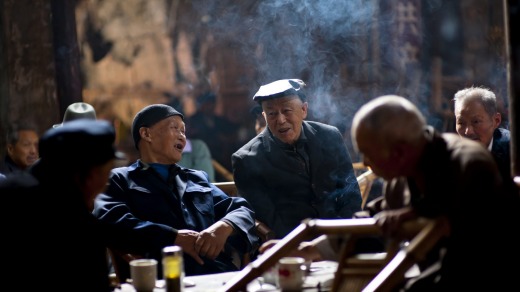
Roujiamo, or shredded meat wedged between two pieces of steamed bread, is the local hamburger. Every vendor has their own special filling, some potent with numbing Sichuan pepper. Open-fronted restaurants display pyramids of skewered meats, grilled for the finger-licking pleasure of passers-by, or served up with a large round of flatbread to those who linger at rickety outdoor tables. Spare ribs, stewed oxtail, lamb dumplings, and mutton or beef soup poured over cubes of bread are other options.
For dessert, nibble on nuts, seeds and preserved fruits, or try the local speciality known as eight-treasures pudding, made from glutinous rice cooked up in little pots and sprinkled with sugar and sesame seeds.
Beijing isn't the best city for street snacks. Islands of street eating survive, but they're best suited to diehard Sinophiles. In Sanlitun district behind the swish Apple store you'll find a laneway where youngsters squat on plastic stools and join the lucky dip of a hotpot, pulling out pig's ears and misshapen fungus with their chopsticks.
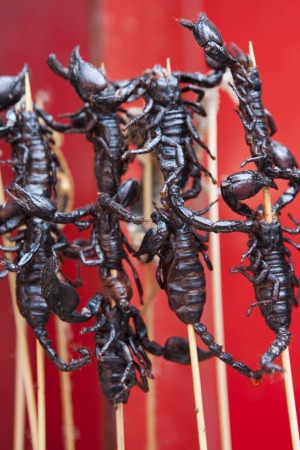
Right off fancy shopping drag Wangfujing Street (where you can resort to a McDonald's takeaway if you must) you'll find alleys where raucous locals devour chicken and dumplings. The reckless can try scorpions with their Green Leaf beer, speared on cocktail sticks. If you have a fascination for the peculiar, Donghuamen night market provides scorpions, crickets and lizards.
Beijing's Back Lakes district has plenty of open-fronted bars where you can enjoy warmed rice wine if you want to get local, though cocktails and beers abound. Vendors still sell the traditional treats becoming increasingly uncommon in this hipster city. Try pancakes spiked with spring onions, stomach-filling glutinous rice cakes and aniseed-flavoured peas.
The writer travels frequently to China at his own expense.
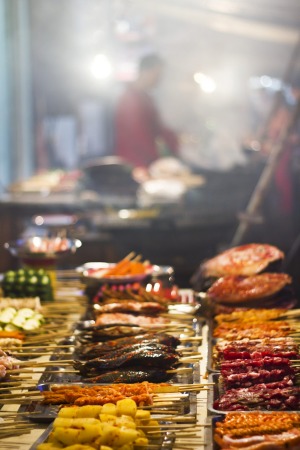
cnto.org
China Southern has flights from Melbourne and Sydney to its hub Guangzhou, and onwards to dozens of domestic destinations in China. See csair.com
Get dizzy at the Grand Hyatt Shanghai, which takes up the 53rd to 87th floors of a Pudong skyscraper. Rooms from $310 a night. See shanghai.grand.hyatt.com
Sofitel Wanda Beijing is Sofitel's flagship property in the Asia-Pacific region and sets out to make a bold statement in service and luxury. Rooms from $160. See sofitel.com/beijing
Shangri-La Hotel Chengdu has the luxe services you expect, and a terrific Qi Spa to heal sore sightseeing feet. Rooms from $203. See shangri-la.com/chengdu